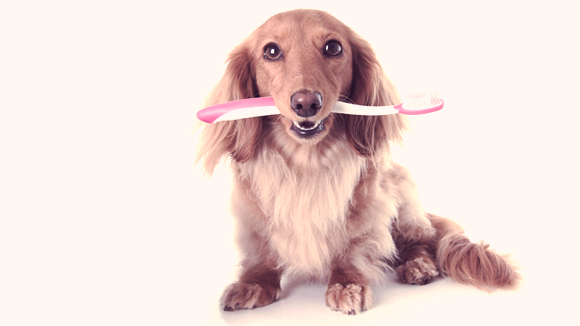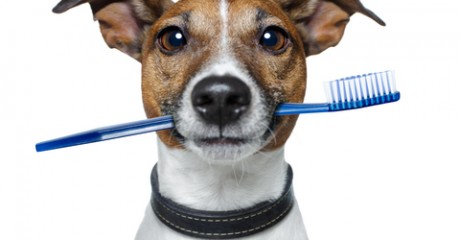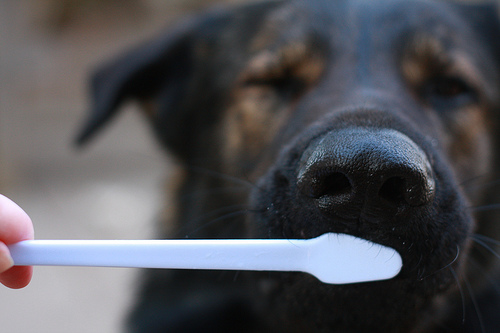How to Properly Brush Your Pets Teeth
Man’s best friend. Actually, they’re everyone’s best friend. Dogs and cats are a quintessential piece of Americana. They’re loyal, selfless creatures that can put a smile on your face, even after a miserable day. Taking care of your best friend should be simple right? Well, not always. In today’s blog, we discuss different ways to take care of your furry friend. Especially dental hygiene.
Why should I brush my pet’s teeth?
It is said that over 2/3 of dogs over the age of three have periodontitis, an inflammation or infection of the tissues surrounding the teeth. Periodontal disease starts as gingivitis and progresses to involve the bony tooth sockets. Left untreated, periodontal disease leads to loss of teeth.
When and where should I brush my pet’s teeth?
Ideally, you should brush your dog’s teeth daily. Daily brushing is the most beneficial and will help to establish a routine for your pet. For many dogs, once brushing becomes a part of their routine, they will begin to expect it. Brushing twice a week is acceptable if your schedule cannot accommodate daily brushing.
“The ideal time to teach your dog to accept tooth brushing is while he or she is still a puppy.”
In the beginning, teaching your dog to accept the brushing of its teeth will take some training, but once he or she becomes accustomed to the process it will be relatively easy. The ideal time to teach your dog to accept tooth brushing is while he or she is still a puppy. If you have an older dog, the training process may take a little longer.
What steps do I need to follow to teach my dog to accept tooth brushing?
In order to be successful at brushing your dog’s teeth, you must make it a positive experience for the pet and you must be patient. You can make the experience positive by praising your dog throughout the whole procedure, and reassuring him or her throughout every step.
For best results, follow these steps:
- Choose a quiet time and place to start the brushing.
- If your dog is small enough, hold your dog securely in your lap, with its head facing away from you. If your dog is larger, you should sit on a chair and have your dog sit beside you so that you can comfortably handle the mouth and teeth.
- Start by rubbing your finger or a soft cloth over the outer surfaces of your dog’s teeth, using a back-and-forth motion. Be careful to stay on the outside surfaces of the teeth to avoid being bitten by accident.
- For the first few lessons, it is a good idea to only rub the cloth along a few teeth rather than the whole mouth, especially if your pet is unsure or nervous about the process.
- Once the dog is comfortable with you rubbing the teeth, let him or her taste a little bit of toothpaste from your finger.
- Once your dog has accepted the taste of the toothpaste, apply a small amount to the cloth and rub it over the teeth.
- Once your dog is completely used to you rubbing the teeth with a cloth, it is time to start using a toothbrush.
- What type of toothbrush should I use?
Commercial toothbrushes are available that are specifically designed for use in dogs. These include brushes with angled handles, brushes with multiple heads (so that you can simultaneously brush the inside, outside and top surfaces of the tooth), small brushes that fit comfortably in your hand, and finger toothbrushes (designed to fit over the tip of your finger). For some dogs, it is acceptable to use a very soft toothbrush designed for use in human babies.
The type of toothbrush you use depends a little on the size of your dog and a little on your own dexterity. Many pet owners find it easier to use a finger brush, especially when first beginning to brush their dog’s teeth.
No matter what type of toothbrush you use, it is important to be gentle and go slowly, since it is easy to accidentally poke the tip of the toothbrush against the gums and cause some irritation, especially when you are first starting to brush your pet’s teeth.
Is it okay to use human toothpaste?
No, absolutely not. Many human toothpastes and oral hygiene products contain xylitol, a sugar substitute that is safe for use in humans but highly toxic in dogs (for further information, see our handout “Xylitol Toxicity in Dogs”).
Even if the human toothpaste does not contain xylitol, it will still contain ingredients that should not be swallowed. If it is swallowed, it can cause an upset stomach or digestive disturbances. Human toothpaste often contains higher levels of sodium than your pet requires, which is another reason why it should not be swallowed.
My friend recommended that I use baking soda. Is this okay?
No. Baking soda is alkaline and if swallowed can upset the acid balance in the stomach and digestive tract. In addition, baking soda does not taste very good, and may cause your dog to be uncooperative when you try to brush its teeth.
Apply a small amount of toothpaste to the toothbrush. Gently raise your dog’s lips on one side. You can either do this by pushing up on the lip with the index finger of your free hand as shown in the diagram, or by placing your free hand over your dog’s head with your thumb and index finger on opposite sides of your dog’s upper jaw and lifting the lips.
If you are using a rubber finger toothbrush, place it along the gum-line and rub the tooth in a circular motion. If you are using a regular toothbrush, you may find it easier to use a back and forth motion. Start from the back, brushing the large upper cheek teeth on their outside surfaces. Work towards the front of the jaw.
In order to brush the lower teeth, you will need to open your dog’s mouth just a little. This can be done by gently tilting your dog’s head backward while holding onto his or her upper jaw with the thumb and index finger of your free hand.
At the beginning, concentrate on brushing the large cheek teeth and the canine teeth, the teeth where plaque and tartar accumulate the most quickly. Gradually work up to brushing all of the teeth (this will probably take several days or weeks).
Do not worry about brushing the tips or insides of the teeth unless your dog is very cooperative. Most of the periodontal lesions occur on the outer surfaces of the teeth and this is where you should direct your efforts. In addition, the dog’s tongue tends to remove a lot of the plaque from the inner surfaces of the teeth, reducing the need for brushing these surfaces.
How long should I take to brush my dog’s teeth? Try to brush for approximately 30 seconds per side.
What else can I do to maintain my dog’s dental health?
Plaque or biofilm is a gummy substance that begins to accumulate on the teeth within hours after a meal. Within a day, plaque combines with salts that are present in the saliva, mineralizing to become tartar. You can feed your dog a special dental diet that is designed to reduce the accumulation of plaque on the teeth, and give your pet special dental chew toys or treats that help remove plaque buildup. In addition, you can use an oral rinse designed for use in pets (can be safely swallowed) to help reduce the bacterial count in the mouth, reducing the formation of plaque and resulting in improved breath.
Finally, have your veterinarian perform a complete oral health examination and prophylactic dental cleaning and polishing under general anesthetic on a regular basis, such as annually.
Is there anything else I should know?
Yes. A dog’s mouth contains plenty of harmful bacteria, so it is extremely important that you wash your hands thoroughly with soap and water after you are finished. Also, rinse the toothbrush thoroughly before putting it away, and replace the toothbrush regularly. If you have several dogs, you should have a different toothbrush for each of them.



